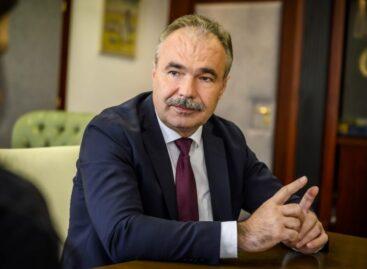There will be no shortage of domestic pumpkins this year either
Hungarian pumpkins have already appeared in the shops, and domestic producers will supply the market with the healthy autumn treat until the end of February, according to the overview of the National Chamber of Agrarian Economy (NAK) and the Hungarian Vegetable and Fruit Association (FruitVeB). Buyers can no longer only take home whole pumpkins, the cleaned and cut goods are also lined up on the shelves in accordance with consumer needs. In order to achieve the richest taste experience, the breeders created a new type of pumpkin, the recognition of which is still in progress.

(Photo: Pixabay)
With the arrival of autumn, the popular pumpkin season has also arrived. From September to the end of February, buyers can find almost exclusively Hungarian pumpkins in the markets and shops, only a small amount of imported goods enter the country. Due to changes in consumer habits, there is an increasing demand for sliced pumpkins on the market, and producers and processors react to this by now also supplying the market with ready-to-cook – cleaned and sliced - pumpkins.
There are two types of pumpkins in the domestic offer
The giant pumpkin has a long growing season, the so-called winter pumpkin, its color is varied, its shape can be an elongated cylinder, oval, flattened, round, or heart-shaped. The color and thickness of the meat also varies. This species includes, for example, Nagydobosi, Muscade de Provance (Muscade pumpkin), and Hokkaido pumpkin, a version of giant pumpkins, which is adding color to the offerings of more and more shops and greengrocers. The so-called musk pumpkins are also popular, including the elongated orange Canadian pumpkin. Although its flesh is sweeter, it can be kept for a shorter time, unlike the Nagydobosi pumpkin. According to the joint overview of NAK and FruitVeB, 1,600-1,800 hectares of pumpkins are grown in Hungary every year, and farmers deal with the Nagydobosi variety on around 400-500 hectares. The total yield in the country is 35-40 thousand tons. While the yield of the Nagydobosi variety is 10-12 tons per hectare, mainly due to the weaker sandy growing areas, the yield of an irrigated pumpkin belonging to the Orange variety group with good soil fertility can reach 70-80 tons per hectare. It is no coincidence that the Orange variety group dominates the domestic market.
Unfortunately, there is no reliable technique that can be used to determine whether the pumpkins available on the market and on store shelves have the desired flavor
In response to this problem, the breeders created the Téli Paráz variety, which has been protected by the National Intellectual Property Office since September 1, 2023. The brand was presented at last year’s OMÉK. The new variety has retained the taste of the old Grand Drummer, its gray exterior and orange interior color. Its new features are high individual weight (10-18 kg), round shape, relatively unribbed surface, uniform meat thickness of 3-5 cm and an amber-colored seed. The recognition of Téli Paráz as an independent pumpkin variety is still in progress. Since the Nagydobos variety ripens continuously, not all pumpkins are ripe for harvest, gray-skinned pumpkins are often placed on the shelves in an immature state due to errors in production technology and crop sorting. This problem can be eliminated by the spread of the Téli Paráz variety. Brand protection ensures that only those who comply with the varietal use, production and selection regulations can use the Téli Paráz brand name, thus guaranteeing its outstanding taste.
Although pumpkin is considered a healthy delicacy thanks to its favorable content, domestic consumption has been stagnant for years
At the same time, the consumption of pumpkin is extremely important from the point of view of preserving our health, as it also contains many vitamins and minerals – calcium, zinc, manganese, iron, as well as vitamin C, vitamin A, B1, B2 and B6. Pumpkin is rich in alpha-carotene and beta-carotene, which the body converts into vitamin A (retinol). This is also the reason why the flesh color of winter squash (squash) ranges from yellow to orange. The deeper the orange shade, the higher the beta-carotene content of the pumpkin. Due to its rich carotenoid content, it is also widely used in the cosmetics industry, thanks to its antioxidant effect it protects the skin against oxidative damage and aging, and improves the stability and shelf life of cosmetics.
NAK
Related news
NAK: it’s worth buying Hungarian sausages on New Year’s Eve too
🎧 Hallgasd a cikket: Lejátszás Szünet Folytatás Leállítás Nyelv: Auto…
Read more >This year, 10 percent more new wine was produced than last year
🎧 Hallgasd a cikket: Lejátszás Szünet Folytatás Leállítás Nyelv: Auto…
Read more >AM: Government helps farmers with a loan moratorium
🎧 Hallgasd a cikket: Lejátszás Szünet Folytatás Leállítás Nyelv: Auto…
Read more >Related news
The GVH imposed fines of more than 3.7 billion forints on 29 companies in 2025
🎧 Hallgasd a cikket: Lejátszás Szünet Folytatás Leállítás Nyelv: Auto…
Read more >Hungary’s economy in 2025: recovery from slowdown, weaker forint and the increasing importance of corporate strategic decisions 2026 will be a test of resilience
🎧 Hallgasd a cikket: Lejátszás Szünet Folytatás Leállítás Nyelv: Auto…
Read more >NAK: it’s worth buying Hungarian sausages on New Year’s Eve too
🎧 Hallgasd a cikket: Lejátszás Szünet Folytatás Leállítás Nyelv: Auto…
Read more >





